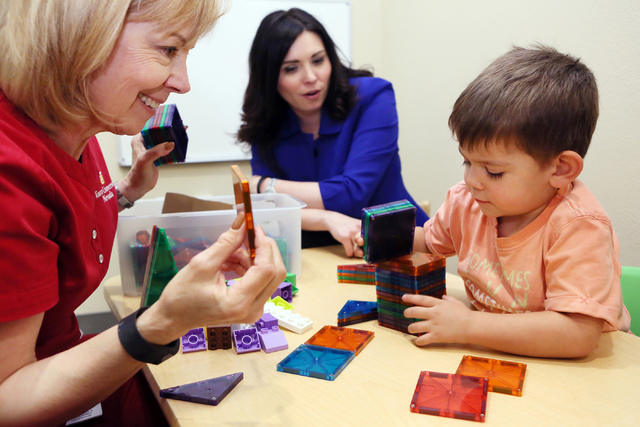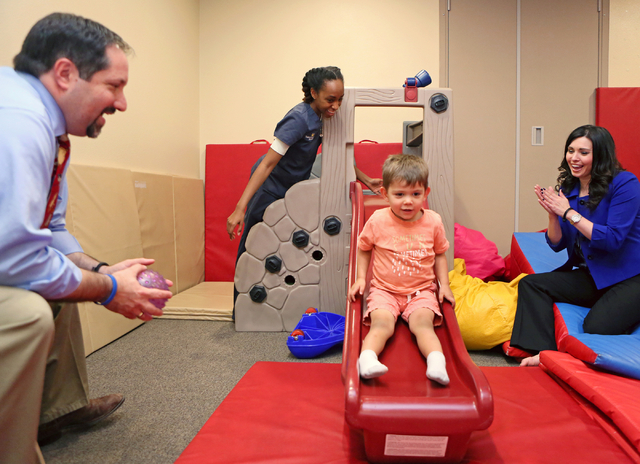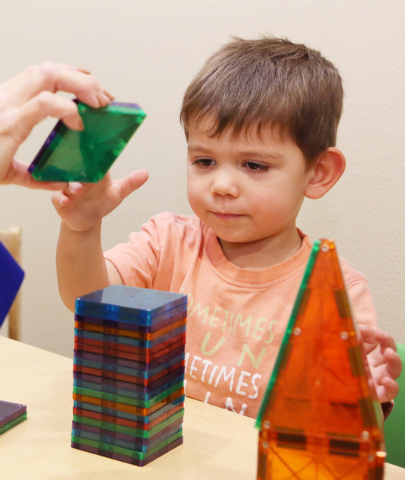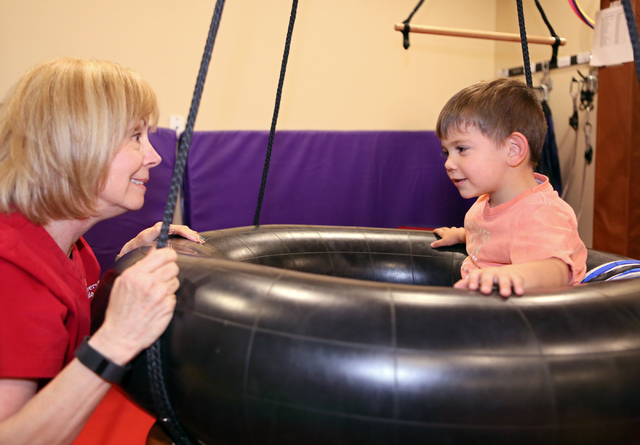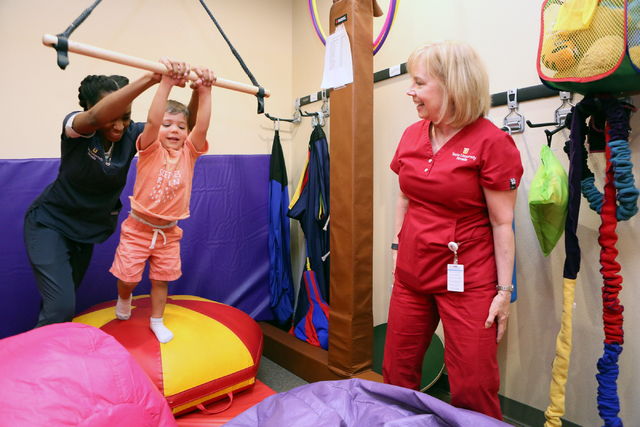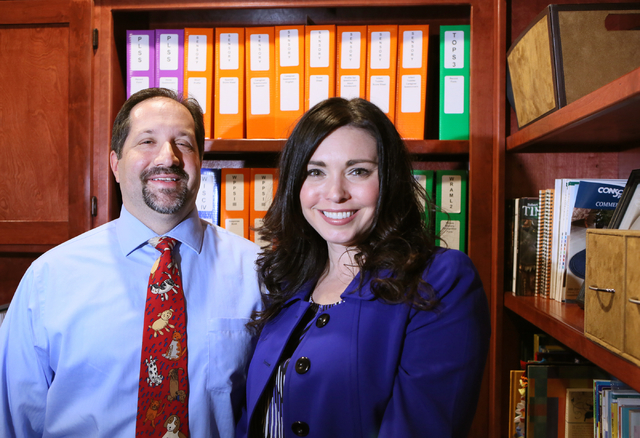From ‘Rain Man’ to vaccinations, myths still surround autism spectrum disorders
When Marlea George’s daughter, Mara, was diagnosed with autism spectrum disorder just more than three years ago, George — like, probably, most people — didn’t know much about it.
George already had suspected something was amiss. For instance, Mara would spend long periods off by herself, George says, and Mara hadn’t yet seemed to acquire the social and interpersonal skills kids usually develop by third grade.
But, George says, “when the pediatrician first used the word ‘autism,’ I’m thinking very severe autism. I didn’t know there was a spectrum and there were different levels to it.
“We were thinking, ‘A child that would not be able to function on her own, (and who is) very dangerous to herself and other people.’ So we were thinking, ‘There’s no way. That’s not Mara at all.’ ”
Autism is discussed more than ever, but it remains for many a frightening, mysterious malady. Couple that with the often-extreme depictions of autism often seen in movies, on television and in popular culture, and it’s probably unsurprising that so many myths surround it.
Greater public awareness of autism — now more properly referred to as “autism spectrum disorder” — has made the public’s perception of what it is and what it isn’t “better than it used to be,” George says, and Nicole Cavenagh, clinical director of the Center for Autism & Developmental Disabilities at Touro University Nevada, would agree.
“I think we are getting better, with people understanding it better,” Cavenagh says. “We’ve had progress in the last 10 to 15 years in that area, but I think there still are a very large number of misconceptions, both in terms of what autism spectrum disorder does actually look like, its symptoms and things like that.”
April is National Autism Awareness Month. Here’s a rundown of some common myths and misconceptions about autism spectrum disorders.
• • •
Myth: Autism is a single condition with a single set of symptoms, and autism spectrum disorders manifest themselves the same way in every person.
Actually, symptoms of autism spectrum disorders can be frustratingly subtle, particularly in younger children.
“For almost two years, we just thought (Mara) was a loner and she was just a little bit slower behind everyone else,” George says. “We used to tease Mara. We’d say, ‘Oh, Mara’s just in her little world.’ Well, she actually was, and we just kidded her, being silly.”
Although autism can present itself in the forms of deep uncommunicativeness, repetitive motions and the more extreme behaviors seen in pop culture, that’s hardly universal.
“There is still sort of the pervasive concept that autism is a binary thing, that you’ve either got it you don’t,” explains Dr. Andrew Eisen, a pediatrician and medical director of the Center for Autism & Developmental Disabilities at Touro University Nevada. “And, really, it’s the subtleness and breadth of the (autism) spectrum that can make it so much more complex.
“(There are) people who are severely affected, people who are easy to identify from a distance,” Eisen says, but “those aren’t the only people who are on the autism spectrum.”
Autism spectrum disorders can manifest themselves as a social awkwardness, or a child’s desire to spend hours alone, or a seeming inability to interpret nonverbal feedback from others. Because the signs and severity of it can be so varied, there’s no one-size-fits-all treatment.
Rather, Cavenagh says, treatment must be tailored to each person, taking into account his or her own strengths and challenges.
One generality that is valid, Cavenagh says, is that “if you know one child with autism … you know one child with autism.”
• • •
Myth: More Americans are being diagnosed with autism than ever.
This one’s true. It’s just that the reasons are more complicated than the statement reflects.
The U.S. Centers for Disease Control and Prevention estimates that about 1 in 68 children have been identified with autism spectrum disorder. And, the CDC adds, “more people than ever before are being diagnosed with (autism spectrum disorders).”
But here’s where things get murky.
First, Cavenagh says, “autism” didn’t become an official diagnosis in the United States until 1980, and the diagnostic criteria “were pretty narrow” back then.
What did it take to receive a diagnosis of autism back then?
“Think of the movie ‘Rain Man,’ ” Cavenagh says.
“Since that time, we have, through research, learned that there are very high-functioning individuals who have autism spectrum disorders, and there are individuals who are severely affected by autism spectrum disorder, and everything in between,” Cavenagh says. “So the broadening of the classic criteria certainly means people who were not being counted before are (now) being counted.”
More recently, the span of autism spectrum disorders has been revised to include such previously independent conditions as Asperger’s syndrome and a diagnosis called “pervasive developmental disorders, not otherwise specified,” Cavenagh says.
“(Although) it sounds like we’re lumping everybody into a huge category,” she says, the new rubric allows greater precision in diagnosis and a greater range of potential treatment options.
“It’s not that we want to label kids,” Eisen adds, but “we have kids who could benefit from interventions, and we want that earlier and earlier.”
The apparent greater prevalence of autism spectrum disorders also could be a function of earlier diagnosis.
The CDC says a reliable diagnosis of autism spectrum disorders can be made as early as age 2. But, Cavenagh notes, it wasn’t terribly long ago that kids weren’t being diagnosed until they were 5 or 6 years of age.
Eisen says that’s important because earlier diagnosis leads to earlier intervention, and earlier intervention is key to effective treatment of children.
The CDC says it remains “unclear” how much of this increase in autism cases is due to “a broader definition of (autism spectrum disorder) and better efforts in diagnosis. However, a true increase in the number of people with an (autism spectrum disorder) cannot be ruled out.”
Cavenagh agrees.
“It may well be that an actual increase in autism is occurring,” she says, and some studies do suggest that “all of the increase in cases cannot be accounted for” by relabeling and earlier diagnosis.
So, she says, there may be another causal factor, “but we don’t know what it is yet.”
• • •
Myth: Autism is caused by vaccines.
Cavenagh says that when a parent receives a diagnosis of autism spectrum disorder, “the single most difficult question they ask me is, ‘Why? Why my child? Why our family.’ And I don’t have a good answer for them, unfortunately, yet.”
“I don’t fault people at all for wanting to find a cause,” Eisen says. “It’s very dissatisfying for us, as well, that we can’t say, ‘This is the specific cause.’ And, unfortunately, we don’t know what that is yet.”
At the same time, “we know what some of the causes are not,” Eisen continues, and “there is no theorized cause that has been more intensively studied than vaccines. And not a single study has supported the proposition that vaccines are, in any way, the cause of autism.
“Really, two big pieces matter here,” Eisen says. First, “the single ‘study, and I put ‘study’ in quotes” that advanced a link was unethically done, not designed to study autism, used made-up data and was “very, very small.”
The paper by Andrew Wakefield later was retracted by the medical journal that published it.
“So this guy pulled a fast one on people,” Eisen says, even as vaccination rates have dropped and “kids have died.”
“The second piece is, we have data from both the U.K. and Japan. There have been vaccination scares and we’ve seen dramatic drops in measles immunizations, followed shortly thereafter by an increase in measles — not a surprise — and as soon as the scare passes and immunization rates come up, the measles rate drops. And through it all we see no significant change in the autism rate.”
Cavenagh adds that, “here, in our practice, we see a very large number of kids who are unvaccinated, and they’re the age of onset of symptoms of autism spectrum disorder, and they are actually the same as kids who were vaccinated.”
• • •
Myth: Autism is caused by emotionally cold mothers or bad parenting.
The short answer, Cavenagh says, is “absolutely not.”
Yet, George has heard that one, and admits that it was hard not to question her own parenting after Mara’s diagnosis.
“At first, we were thinking, ‘What were we doing wrong?’ ” she says. “What were we doing wrong that we didn’t do with the older ones? ”
• • •
Myth: People with autism spectrum disorders have savantlike abilities, like Dustin Hoffman’s character in the movie “Rain Man.”
Real-life counterparts to the film’s depiction are “very rare,” Cavenagh says.
“It’s not something you never see,” she says. “Maybe 1 percent. Still, it’s incredibly rare.”
Eisen adds, “Even 1 percent is rare,” I’ve never seen it.”
But, Cavenagh continues, “to piggyback on that, kids with autism spectrum disorder go to college — not every kid, but not every neurotypical kid goes to college. But they go to college, they have relationships, they get married and have kids.”
Eisen adds that you’ll find people with autism spectrum disorders everywhere in society.
“I’ve seen professionals who are undoubtedly on the (span of) autism spectrum disorders. I’m talking physicians, attorneys, people in elected office.”
“The question I always get asked is, ‘Is (Mara) really smart?’ ” George says. “That’s always it: They’re either really, really smart or they can’t function at all.
“She does everything we do. She just processes information in a totally different manner. She is very smart. Her testing scores always exceed the standard. But getting her to turn in her homework — doing her homework — or remembering that we need to be somewhere at 10 a.m., those everyday things just don’t matter to her.
“If you just look at Mara, you’ll never know that her brain is a little different than ours. She’s a typical girl. She’s growing up. She’s really tall. She’s bubbly.”
• • •
Myth: Autism is curable.
“There are folks who say they can cure autism,” Eisen says. “What I would say about that is, there are a variety of treatments that are effective, but a lot of what’s out there is snake oil.”
Eisen likens treatment of autism spectrum disorders to the treatment of diabetes.
“When you talk about diabetes, we don’t cure it,” he says. “But it can be managed, and you can improve outcomes if you manage it well.”
Cavenagh says, “We can improve outcomes. We see it every day in our clinic here. We provide evidence-based therapies, and that’s an important phrase. You wanted it to be grounded in empirical research, things that we know are going to be effective.”
And, Eisen says, “We know early intervention is paramount to success. The earlier we are able to provide intervention, the better the outcomes will be for these kids.”
Contact reporter John Przybys at jprzybys@reviewjournal.com or 702-383-0280. Follow him on Twitter @JJPrzybys.



